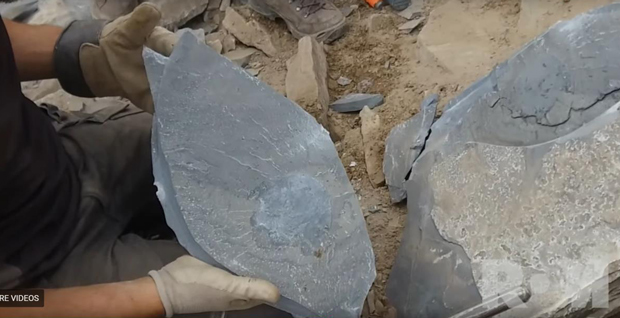The Predatory Cambroraster falcatus from the Burgess Shale
Palaeontologists at the Royal Ontario Museum and the University of Toronto have announced the discovery of a new 500-million-year-old predator, adding to the diversity associated with the Cambrian-aged Burgess Shale biota. The animal, a distant relative of today’s spiders, insects and crustaceans, has been named Cambroraster falcatus. At around thirty centimetres in length C. falcatus was one of the biggest animals around in the Late Cambrian and it was a distant relative of the formidable Anomalocaris, the apex predator on Earth during this time in our planet’s history.
A Life Reconstruction of Cambroraster falcatus
Picture credit: Royal Ontario Museum
Providing New Information About the Diversity of Early Arthropods
Fossils of this newly described species were found in the Kootenay National Park in the Canadian Rockies. Cambroraster has rake-like claws and a pineapple-slice-shaped mouth at the front of an extremely large head, it probably used its rake-like claws to sift through sediment and trap prey.
Lead author of the scientific paper published in the Proceedings of the Royal Society B (Biology), Joe Moysiuk, based at the Royal Ontario Museum stated:
“Its size would have been even more impressive at the time it was alive, as most animals living during the Cambrian Period were smaller than your little finger. Cambroraster was a distant cousin of the iconic Anomalocaris, the top predator living in the seas at that time, but it seems to have been feeding in a radically different way.”
Revealing a Fossil of a Cambroraster at the Kootenay National Park Field Site

Image credit: Royal Ontario Museum
Cambroraster falcatus – Remarkable Claws and the Millennium Falcon
The name Cambroraster refers to the remarkable claws of this animal, which bear a parallel series of outgrowths, looking like forward-directed rakes. With the space between the spines on the claws at typically less than a millimetre, this would have enabled Cambroraster to feed on very small organisms, although larger prey could also likely be captured, and ingested into the circular tooth-lined mouth. It is this specialised radial mouth that links Cambroraster to the Radiodonta, a clade of stem arthropods that were geographically widespread during the Cambrian, with many genera evolving into large nektonic predators.
The species or trivial name “falcatus”, is in honour of another of this marine animal’s distinctive features – the large, shield-like carapace covering the anterior part of the body. This shield reminded the scientists of the iconic spaceship the Millennium Falcon from the Star Wars movie.
Graduate student Moysiuk added:
“With its broad head carapace with deep notches accommodating the upward facing eyes, Cambroraster resembles modern living bottom-dwelling animals like horseshoe crabs. This represents a remarkable case of evolutionary convergence in these radiodonts.”
The researchers conclude that such convergence is likely reflective of a similar environment and mode of life, like modern horseshoe crabs, Cambroraster may have used its carapace to plough through sediment as it fed.
A Large Number of Specimens Found
Co-author of the paper, Dr Caron, an Assistant Professor at the University of Toronto commented:
“The sheer abundance of this animal is extraordinary. Over the past few summers we found hundreds of specimens, sometimes with dozens of individuals covering single rock slabs.”
Based on over a hundred exceptionally well-preserved fossils now housed at the Royal Ontario Museum, the researchers were able to reconstruct Cambroraster in unprecedented detail, revealing characteristics that had not been seen before in related species.
Dr Caron added:
“The radiodont fossil record is very sparse, typically, we only find scattered bits and pieces. The large number of parts and unusually complete fossils preserved at the same place are a real coup, as they help us to better understand what these animals looked like and how they lived. We are really excited about this discovery. Cambroraster clearly illustrates that predation was a big deal at that time with many kinds of surprising morphological adaptations.”
A View of the Underside of Cambroraster with a Close-up View of the Radial Mouth

Picture credit: Royal Ontario Museum
The Significance of the Burgess Shale
The fossils from the Burgess Shale of British Columbia document a remarkable time during the evolution of life on Earth. There was a huge increase in biodiversity and food chains became much more complex as most of the major Phyla of animals that are around today evolved.
The Cambroraster fossil material comes from several locations in the Marble Canyon area of Kootenay National Park. These locations and others like them are being explored and mapped by field teams from the Royal Ontario Museum. These sites are about 25 miles (40 km) away from the original Burgess Shale fossil site in Yoho National Park that was discovered in 1909. Scientists are confident that more new species will be discovery in this area of Kootenay National Park
Everything Dinosaur acknowledges the assistance of a press release from the Royal Ontario Museum in the compilation of this article.
The scientific paper: “A new hurdiid radiodont from the Burgess Shale evinces the exploitation of Cambrian infaunal food sources” by J. Moysiuk and J.B. Caron published in the Proceedings of the Royal Society B.
Everything Dinosaur’s award-winning website: Everything Dinosaur.







Leave A Comment